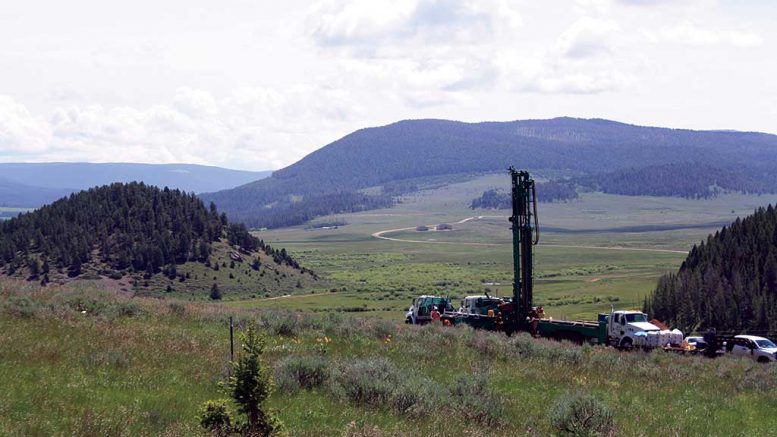Sandfire Resources America (TSXV: SFR; US-OTC: SRAFF) has released the draft environmental impact statement (EIS) for its wholly owned underground Black Butte copper project in central Montana, 27 km north of the city of White Sulphur Springs.
The draft is undergoing a period of public comment that will end May 10, 2019.
After, the draft will undergo a review before Sandfire releases its final EIS.
The company aims to finish permitting at Black Butte as it tables a feasibility study for the project, which it slates for 2019’s third quarter.
“The Montana permitting system is very rigorous,” Sandfire Resources America president and CEO Rob Scargill says in an interview with The Northern Miner. “There are very high standards that have to be met. But the EIS is at the end of the process, which is a little different from other parts of the United States.”
Fortunately for Sandfire, the project sits on private lands, meaning it only has to undergo state permitting, a somewhat less complicated process than federal permitting. The company only needs one federal permit — which it already has.
The process hit a slight delay in late 2018, when Montana introduced a statewide standard for nitrogen during the state’s growing season. It wasn’t hard to address, but Sandfire had to revisit its permit application and add a water-storage pond to the site.
“It adds a capital cost, but it addresses the concerns and will potentially give us operational benefits, as well,” Scargill says.
“Now we have the environmental context at least in draft form for the feasibility study, we can move forward with the more detailed design of mine and processing.”
To bolster the study, the company undertook a 24-hole drill program at Black Butte that ended on March 6, 2019. It gathered geotechnical and hydrogeological data for its forthcoming study, but also tried to raise the confidence level in the resource areas.
“We want to increase the amount of measured and indicated resources so that we can increase the size of the initial reserve for the feasibility study,” Scargill says.
According to a 2013 preliminary economic assessment (PEA), Black Butte contains 15.7 million measured and indicated tonnes grading 3.4% copper, 0.1% cobalt and 13.9 grams per tonne silver for 1.17 billion lb. copper, 36 million lb. cobalt and 6.98 million oz. silver. The project also contains 2.26 million inferred tonnes at 2.8% copper, 0.09% cobalt and 13.8 grams silver for 140 million lb. copper, 4.9 million lb. cobalt and 1 million oz. silver.
The Lowry deposit, which sits 2 km from the proposed mine entrance, has another 4.1 million indicated tonnes at 2.9% copper. However, the Lowry deposit was not fully understood when Sandfire began permitting, and is not included in the current permitting program. As a result, it won’t be included in the feasibility study, either.
“We will make mention to the Lowry, because it’s certainly a resource that we’ll want to look at in more detail as we move forward,” Scargill says. “It has the potential to add another five to eight years to the mine life.”
The PEA assigned Black Butte a US$109 million, after-tax net present value at an 8% discount rate and a 20.2% after-tax internal rate of return. The project would cost US$217.8 million in initial capital and payback would occur in 4.7 years.
The project would produce 30,000 tonnes per year copper concentrate over a 15-year mine life from a relatively shallow underground mine — the project’s Upper Copper zone is 60 to 200 metres below surface, while its Lower Copper zone is 300 to 500 metres below surface.
In June 2018, the company’s CEO John Shanahan passed away suddenly. The company appointed a Scargill CEO in his stead.
Shortly before that, the company changed its name from Tintina Resources to Sandfire Resources America. Sandfire Resources NL (ASX: SFR; US-OTC: SRAFF) owns 78.1% of the company.
“The rationale was that there was some criticism that the company was being used as a front by an Australian company, which is not the case,” Scargill says.
“The other criticism was that opposition groups were pointing at Tintina and saying: ‘How is this tiny little company going to be able to build a mine and run it in the way they say?’ The view taken at the time was that by having Sandfire in the name, that would defuse some of those issues about how this business is going to be funded.”
Shares of Sandfire Resources America are trading at 9¢ in a 52-week range of 6¢ to 11¢. The company has a $73-million market capitalization. It hopes to begin mine construction at Black Butte in the back half of 2019, and enter production mid-2021. At the end of 2018, the company had $13.7 million in cash.
“One of the interesting things is that Sandfire Resources in Australia has a roundabout of 40% U.S. shareholding,” Scargill says. “When you consider that most of the minority shareholders in Sandfire Resources America are actually from the U.S., nearly half of the shareholders in the business are actually U.S. residents.”


Be the first to comment on "Sandfire progresses Black Butte toward feasibility"